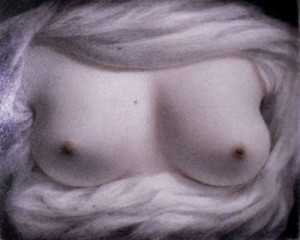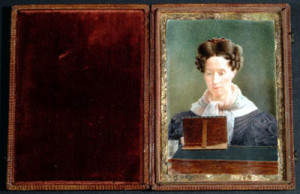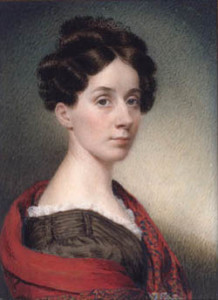Self-Fashioning in Sarah Goodridge’s Self-Portraits

Beauty Revealed, as Sarah Goodridge called it, is an extraordinary self-portrait no matter how you look at it. Goodridge painted it in 1823 on a 2 5/8″ x 3 1/8″ sliver of ivory shaved so thin that light shines through it. The miniature was a gift from the forty-year-old artist to her famous and frequent client, the orator and public servant Daniel Webster. Over the next twenty years, Goodridge would paint her own image two more times, in 1830 and again in 1845. Yet it is to Beauty Revealed (Self-Portrait) that our eyes return. What sort of self did she fashion in that image–and how and why did she modify it over the years?
Self-fashioning refers to the choices made by artists in self-portraits to associate their images with certain items of clothing, hairstyle, furniture, or scenery. Analyzing these choices reveals a unique perspective on an artist’s view of herself. In Beauty Revealed (Self-Portrait) (fig. 1), Sarah Goodridge conjured herself as a kind of visual synecdoche, a part for the whole. Outwardly, at least, the artist offered far more information about her view of herself in her second self-portrait, dated 1830, and in her third and last known self-portrait, ca. 1845. Unlike Beauty Revealed, both of these include facial expressions, clothing, hairstyle, and pose that communicate historical and editorial commentary.
What must Daniel Webster have thought about the self that Beauty Revealed revealed? Of course each brushstroke is a piece of a costume; Goodridge dressed this image with color, shadow, and light. To enhance the three-dimensional effect, she draped the breasts with gradations of color. In order to please the viewer–Webster alone, the miniature format suggests–she crafted each nipple delicately and placed it deliberately and harmoniously. As she mixed the pinks and grays in her paint box, she probably studied her own forty-year-old body and thought about how to best capture its shapes. Through this process she idealized reality. Goodridge costumed these breasts with youth, balance, paleness, and buoyancy. With masterly skill, she used the bare ivory’s luminescence to make the objects seem to glow in particular ways. In this sense the breasts that make up Beauty Revealed are clothed–arranged, fashioned–and we can interpret their adornment as we would any conventional self-portrait.
According to Stephen Greenblatt, the choices artists and writers make about how to fashion their self-representations reveal what he calls “the point of encounter between an authority and an alien.” By authority, he means the shared, referential meaning associated with an object or an item of clothing. By alien he means the figure in the painting, which becomes an alien twin to the artist, frozen in a constructed world. Greenblatt would say that self-fashioning in self-portraiture forces the artist to select a costume. But unlike an actress the painted figure cannot take the costume off when the drama is over. The alien image in the self-portrait separates from the real self, living a different life than its maker whenever it is viewed, often surviving the artist’s corporeal existence, forever captured in relation to certain unchanging objects.
Dozens of Goodridge’s miniatures survive today; they and her neatly written business accounts are the only evidence from her own hand. Sarah Goodridge was a prolific but not lavishly honored miniaturist who made a decent middle-class income from her trade. Born in 1788 in Templeton, Massachusetts, the sixth of nine children, she showed an early propensity for drawing. Informal instruction and self-education, and a move to Boston in 1820, brought her to study with the celebrated portraitist Gilbert Stuart. Under Stuart’s influence her skill increased markedly. Upon arrival in Boston, she opened a studio and commenced a nearly thirty-year career in making miniature portraits, often two or three per week. The Boston Athenaeum held five exhibitions of her work between 1827 and 1835, and Goodrich twice traveled to Washington to carry out commissions for her longtime friend and frequent client Daniel Webster. She never married, and earned enough money to raise an orphaned niece and take care of her invalid mother for eleven years. In 1850, due to failing eyesight, Goodridge retired to a house she bought in Reading, Massachusetts. Three years later she died of a stroke at the age of 65.
Goodrich limned some of her biography into her last known self-portrait, where she fashioned herself as an artist at work at her easel. She was somewhere between forty-five and fifty-two years old when she painted it–older, though not by much, than the self portrayed in Beauty Revealed. Her eyes are lowered, denying the viewer the typical eye-to-eye confrontation that usually adorns self-portraits. Partial views of her water glass, her hand, and her shawl hint at her illustrated profession. Posing herself working at her easel, she assumes an active, preoccupied role, too busy even to look at the viewer/mirror. No other female miniaturist painted herself in this pose, although several men did. This painting distinguishes Goodridge from her same-sex peers–Ann Hall, for example, who painted herself arranging flowers–but aligns Goodridge with such titans of American painting as Benjamin West, Charles Willson Peale, and John Trumbull, all of whom fashioned their self-portraits with palettes, brushes, and easels. Goodridge pictures herself as a working person, proud enough of her occupation to depict herself doing it. Unlike West, Peale, and Trumbull, who gaze piercingly outward at viewers, Goodridge refuses a returning gaze, due not to modesty but to distraction. Forever her alien twin is working, frozen in the act of daubing paint, shackled to what Greenblatt would call the authority of male painters of her era and nation.
Goodridge was a businesswoman as well as an artist, so she must have known that her self-portraits functioned as an advertisement of her skill, as marketing tools, in effect. Her 1845 self portrait is both an example of her work, and it is an illustration of her profession. Potential clients could judge whether this likeness was accurate, and use it to assess the quality of likeness they might see in their own commissioned portraits.
Is this figure alien to the artist? Careful analysis reveals that light falls rather unflatteringly on her brow and neck. This same light bleaches out part of the eyebrow and rather sloppily daubs yellow on the eyelashes on one side, making the pair of eyes seem unbalanced. Neither bright lips nor fashionable hair decorations embellish this figure. In fact, her scarf, her hair, her dress all seem burdens. These gender markers seem to weigh her down. The dark swags of the painted dress and knotted shawl contribute to a yoked feeling. The hair seems a heavy helmet, under which the prim, elderly looking face appears to recede. The flesh tones are as dull as mayonnaise when compared to the luminous colors of Beauty Revealed, where harmonious balance, light, and color dress the illustrated breasts with youthful energy and vigorous health. The pinks on the elder woman’s cheeks do not vibrate as the pinks giving shape to the breasts. All that her first self-portrait promotes is covered over in her final self-portrait, obscured behind the easel, the table, and the heavy clothing.
Painted between Beauty Revealed and the 1845 image, Goodridge’s 1830 self-portrait is a classic of its genre, and it aligns itself with conventional self-portraits by other miniaturists–both men and women. Compared to her last self-portrait, this version of her face seems less burdened, less dour. The color palette for the flesh tones is the same as her first self-portrait; they vibrate with healthful intensity, suggesting a blush. The costume and hair are much more harmoniously arranged around a face that is bright enough to support them. The figure’s off-the-shoulder dress illustrates a certain degree of wealth, as well as her skill at rendering lace and shimmering black silk folds. The hair, too, and an embroidered scarlet shawl reveal her skill at illustrating fabric realistically–as well as her consciousness of fashion, of style. The dynamic 3/4 pose alone aligns the image with all miniatures depicting middle-class women during this period. Nothing in this image betrays the spirit of her first self-image except the pinks and ivories of the skin.
Look into Goodridge’s painted eyes. Peer closer at her face as it regards viewers. Can you see through the image to the artist who painted it? Is there a hint of the erotic spirit that went into painting her first self-portrait? Her willingness to face us implies an intensity, a soul-searching intimacy. The stippled backdrop is unornamented, increasing the tight focal emphasis on the figure. However something about the pose–the figure’s immobility, and the protective shawl–suggests distance, artifice, and coldness. While this figure begs a viewer’s idle gaze to turn into active inquiry, it yields relatively little in return: just an arch expression, a cool returning gaze, and skin tones that hint at warmth. Although almost nothing of the eroticism of Beauty Revealed (Self-Portrait), painted just two years prior, surfaces here, both images confront the viewer directly, appealing to the senses, insisting upon engagement, while yielding none of the intimacy they promise.
As she painted Beauty Revealed, what did Goodridge think about? Did she consider herself to be making an object that crossed the boundaries of conduct, class, and gender expectations? Perhaps these boundaries were less clearly marked than we assume today. We know this image came to Webster as a gift, and like any present it suggests a relationship. Can we infer, then, a degree of intimacy between them? Can we attribute a voice to the image? John Updike recently imagined the breasts saying, “We are yours for the taking, in all our ivory loveliness, with our tenderly stippled nipples.” I agree that Goodridge’s painting communicates availability, but instead of coquettishness, these breasts seem to confront the world of the viewer. They demand attention. They seem to come forward out of the picture plane. This effect is intentional, and it relies upon masterful use of the luminous ivory, which is thin enough to be semi-transparent. The result is that the breasts seem to glow with more light than an opaque surface would allow. The luminosity contributes to the three-dimensional effect, but the gauzy curtain surrounding the breasts really makes them pop out of the frame. Like curtains drawn back on a Vaudeville stage, the painted image of sensuously bulging fabric defines a space devoted to performance and spectacle. The fabric limits the viewer’s gaze, focuses it. The fabric also erases the rest of the body, suggesting instead its shapes in abstractions. More evocatively than words, this image seduces viewers while attesting to frank openness about female erotic power.
What company did Goodridge imagine for her portrait? Other breasts in fine art are famously associated with the Madonna. But given Goodridge’s nonacademic artisan’s training, and her family’s association with the Boston Unitarian church, her idealized breasts probably do not derive their authority from the Madonna tradition of bared breasts in art. Perhaps a more likely source for this image is the Venus/Aphrodite motif. She would likely have seen Greenough’s “Venus Victrix” in at the Boston Athenaeum, a sculpture whose breasts are no less ideally represented, albeit in marble and in three dimensions instead of in watercolor on a flat surface.
Goodridge gave this image to Senator Daniel Webster in 1828. Some would argue that its meaning is therefore private, impossible for outsiders to know. However the stage, with its curtain drawn back, implies a far more public performance than an audience of just one. Fashioning the image with youth and availability suggests a universal appeal. Aligning the image with representations of a pre-Christian goddess broadcasts beyond the private intimacies shared by Goodridge and Webster alone. Goodridge’s first self-portrait communicates a message about erotic license in Anglo-American culture during the 1820s, and communicates it from a woman’s perspective, from someone who did not conform to the domestic stereotype that her peers valued. Any modesty clings to the curtain, which is drawn aside, revealing without shame, without demurring from the viewer’s gaze.
The title Goodridge gave this self-portrait–Beauty Revealed–suggests that it should be associated with abstractions like “Beauty” (for which Venus is often a simulacrum) and surprises that get “Revealed” after a veil is lifted. The title exhibits the confidence with which she painted and labeled her breasts. Certainly she painted them for Senator Daniel Webster’s pleasure, but to some degree she also painted them for other eyes as well. She fashioned them for audiences in the future, and she relied upon the tradition of pre-Christian celebrations of female desire as a reference to authority. What is beautiful should be revealed, her self-portrait seems to say, and the curtain emphasizes the revelation.
Perhaps the only other nineteenth-century text that dares to express the erotic jouissance of nineteenth-century, middle-class, Anglo-American culture is Walt Whitman’s “Song of Myself,” composed almost thirty years after Goodridge painted Beauty Revealed (Self-Portrait). Whitman’s poem, like Goodridge’s painting, promotes erotic uses by readers and viewers. In “Whoever You Art Holding Me Now in Hand,” for example, Whitman tells readers to “put your lips upon mine I permit you,” and to thrust his book “beneath your clothing, / Where I may feel the throbs of your heart or rest upon your hip.” Like Goodridge’s self-portrait, Whitman’s autobiographical verse joyously defies staid, conventional, shame-ruled representations in print and in pictures. Beauty Revealed (Self-Portrait) and Whitman’s autobiography fashion their makers’ naked bodies with a kind of promise, an effort to reach out and through the representation to viewers. They invite the gaze of readers and viewers without judging them or turning into a coy pose.
Assessed as a group, Goodridge’s self-portraits demand a revision of the popular view that middle-class white women in the Jacksonian period conformed universally to the doctrine of sentimental domesticity, with its rigid prescriptions for a woman’s modesty, chastity, piety, and purity. The three miniature paintings fashion versions of a woman who deviates radically from a stereotype, but also conforms to it. Think of Goodridge, therefore, as that particularly American stereotype, the Jack of all Trades, whose opportunism was an essential component of the freewheeling Jacksonian Democracy that emerged among the second generations of U.S. citizens during the 1820s-40s. Like Whitman’s autobiographical poem, Goodridge’s self-portraits reveal selves large enough to contain multitudes, but whose real power lies in the one-to-one intimacy with the reader or the viewer.
Further Reading: See Stephen Greenblatt, Renaissance Self-Fashioning: From More to Shakespeare (Chicago, 1980); John Updike, “The Revealed and the Concealed: An Extraordinary Love Token Holds the Key to America’s Ambivalent Relationship with the Nude,” Art & Antiques 15 (February 1993): 70-76.
This article originally appeared in issue 4.1 (October, 2003).
Chris Packard teaches at New York University. His essays have appeared in Arizona Quarterly and Concerns. His book Queer Cowboys and Other Erotic Male Friendships in Nineteenth-Century American Literature will be published by Palgrave/St. Martin’s Press in early 2004.


